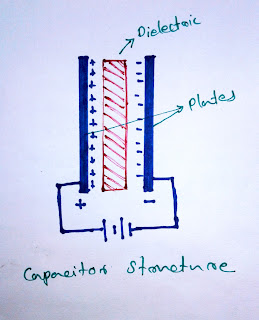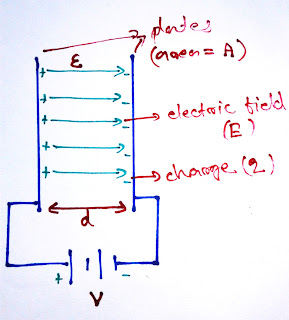HOME MADE CAPACITORS
 |
| DIY paper capacitor |
 |
| DIY paper capacitor |
Here in this blog I explain something about capacitors and teach you to make a simple capacitor in your home. So, first we discuss about capacitors and then about the DIY capacitor making.
 Capacitor
Capacitor
Basically what is a capacitor? It is a basic electronic component which stores electrical energy. It is a passive device. It has only two leads. It is used in circuits to filter the AC signals. It is commonly used in rectifier filter circuits and in audio RF filter circuits and also in resonance circuits. In resonating circuits it act as a frequency selecting device. These are the common details about capacitors.
Construction & working
Capacitor is made by placing an insulating dielectric material between the two electrically conducting plates. When connecting a voltage source (battery) to the capacitor, the plates become oppositely charged and there create an electric field in-between the two plates. The energy is stored in the produced electric field between plates. When the battery removed, there is nothing happen. The energy is still appear in the electric field. So in capacitors the energy is stored in the direct electric form. But in batteries the energy is stored in the form of chemical energy. It is the major difference between capacitor and battery.
Capacitor Equations
Equation are used to model the capacitors with the help of mathematics. It indicate the relation between different factors in capacitors like voltage, current, charge, etc... It is not electronics, it is just a tool to simplify the complexity of capacitors for everyone. Main equation are given below.
 |
| Capacitance equation |
 |
| Current equation |
The first equation indicate the relation between capacitance and the capacitor physical dimensions. The constant in the equation is dielectric constant depend on the properties of the dielectric material. This equation tell that the capacitance is increases with increase in the area of plate and decrease with increase in the distance between the plates.
The second equation indicate the relation between current and voltage with the capacitance.
Capacitor Connections
The capacitor is arranged in series and in parallel. In series arrangement the capacitance decreases and the voltage rating increases. In parallel arrangement the capacitance increases and the voltage rating still same. These are given in the figure given below.
 |
| Capacitor in parallel |
 |
| Capacitor in series |
Different type of capacitors
 |
| Electrolytic capacitor |
1. Electrolytic capacitor
It is commonly present in high capacitance value ranging from few micro-farads to 10000 micro-farads. It have polarity. The reverse polarity cause damage to it. The dielectric used here is an electrolyte, So it is known as electrolytic capacitor. Commonly it is used to store charges in capacitor. Thus it is used as filter capacitors in rectifiers.
It is made up of ceramic material as dielectric. Commonly it is available in small values ranging from pico-farads to nano-farads range. It have no polarity. Commonly it is rated for high voltages. Commonly it is used for filter application and in RF circuits. It is available in small sizes and also preset in SMD packages.
3. Tantalum capacitor
These are high precision capacitors. It have polarity. It is marked on the surface. It is available in wide ranges. It is used for filtering purposes.
 |
| Film capacitor |
4. Film capacitor
It is a commonly used type. It is available in nano-farad ranges. It is good for filter applications in audio circuits. Commonly it is rated for high voltages.
5. paper capacitor
Here the dielectric in between the plates is paper. Use aluminium sheets and paper sheets for constructing it. The alternate paper and aluminium sheets form a stack and it produce more capacitance than a single sheet. It available in small values. It is used for filters.
Capacitor Making
 |
| Plan |
Now we are know something about capacitors. It never ends, I am still study about capacitor in every day. Here I plan to make a paper capacitor. From the name we get that the dielectric here is paper. The plan is given in the image. I use a magazine paper because it has a plastic coating. It decrease the leakage between the capacitor plates. The plates are made by using the aluminium foil. The procedure is given below,
- Prepare the magazine paper and aluminium foil (cutting)
- Take a paper and stick the aluminium foil in each side by using glue
- Connect two wires from each aluminium foil side
- Insulate the two plates by covering with two magazine paper in each side using glue
- Roll up the capacitor into a cylindrical shape
- Finally add wrap some plastic stickers for finis it
The process is given in the video.
Note: Ensure that the two capacitor plates (aluminium foil) are not touch to each other. If there is a shot circuit it do not work.
The detailed making procedure is given in my instructable page. The link is given below,
https://www.instructables.com/id/Paper-Capacitor



Heartily appreciate your contribution Because that is unbeatable informative content. Leading disc type capacitor supplier in India.
ReplyDeleteSo much lovveee. I was literally confused on how it works. 😣
ReplyDeleteLot of thanks for this blog, there is so much reality written in this content and everything is very hard to be argued. A top-notch blog having excellent content.Aluminum wiring is very useful for house and office .Aluminum wiring in homes
ReplyDeleteThank You Very Much For Great Post. Dc Capacitor do not play an important role in DC circuits because it is impossible for a steady current to flow across a capacitor.
ReplyDeleteDiy Home Made Capacitors (Paper Capacitor And Its Theory) >>>>> Download Now
ReplyDelete>>>>> Download Full
Diy Home Made Capacitors (Paper Capacitor And Its Theory) >>>>> Download LINK
>>>>> Download Now
Diy Home Made Capacitors (Paper Capacitor And Its Theory) >>>>> Download Full
>>>>> Download LINK mu
ReplyDeletethanks for sharing great blog >>>>>>Read more About
DIY Condenser Mini Split AC
Very nice post electronics component suppliers
ReplyDeleteGreat post. Thanks for sharing. Alternator Capacitor
ReplyDeletegood blog
ReplyDelete
ReplyDeleteGood information.
----------------------------------------
I work in visit Stabilit America
Magnificette Buy High-Quality Electronic Components Online - Cables, Connectors, ICs and More - Shop the best electronic components online including cables, connectors, active and passive components, power supplies, optoelectronics, and more. Fast shipping and great prices!
ReplyDeleteThis comment has been removed by the author.
ReplyDeleteThis comment has been removed by the author.
ReplyDeleteGreat post! Your step-by-step guide on making a DIY paper capacitor is both informative and engaging. It’s impressive how you’ve demonstrated the simplicity and effectiveness of creating a capacitor using everyday materials like aluminum foil and paper. This hands-on approach not only deepens understanding but also sparks creativity in electronics. For those interested in exploring more about capacitors, including AC capacitors, you might find Indtech Capacitors
ReplyDeletea valuable resource.
Visit: https://www.indtechcapacitors.com/
Great post! Your DIY approach to building paper capacitors is creative and educational — the clear step-by-step guide helps even beginners understand how capacitance works and the impact of materials and geometry. It’s a nice blend of theory and hands-on experimentation. For high-performance industrial capacitors designed for precision and reliability, you may want to check out our solutions at Indtech Capacitors.
ReplyDeleteVisit: https://www.indtechcapacitors.com/
Great article! As someone always looking for high-quality electrical components, I completely agree that choosing the best capacitor in India plays a major role in performance, safety, and long-term reliability. Manufacturers like Indtech Capacitors are doing excellent work by delivering durable and efficient capacitor solutions for industrial and commercial applications. Anyone exploring trusted options can visit us to learn more about their wide product range and quality standards.
ReplyDelete